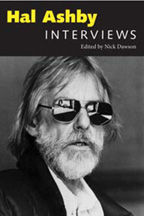(University Press of Mississippi, 128 pages, $22)
Edited by Nick Dawson
 "My experience as a director has always been that the moment you start directing that creative flow in somebody, you’re doing them a disservice 99 percent of the time because you’re throwing them off."
"My experience as a director has always been that the moment you start directing that creative flow in somebody, you’re doing them a disservice 99 percent of the time because you’re throwing them off."
Thus speaks the late Hal Ashby, brought back from the grave by Nick Dawson’s valuable compilation of interviews. Time and again, Ashby stresses his desire to remain hands-off in his direction of actors and their instincts. Ashby’s collaborators—from Jack Nicholson and Warren Beatty to Jeff Bridges and Jane Fonda—recall the director’s open-minded, almost ego-less desire to invite the contributions of everyone on set. “Otherwise you cut off ideas too fast,” said Ashby in a 1980 interview. “The great thing about film is, it really is communal—it is the communal art... The more input you could get, the better it is.”
Ashby’s work is united not so much by thematic or stylistic qualities (could Being There and Bound for Glory be any more different?), as by a looseness in his creative process that amounted to a kind of strategic directorial self-effacement. “‘A Hal Ashby Film?’” he mused in 1975, “I’m not sure what that means exactly,” while in the same interview he declines to define any kind of “personal philosophy” motivating his work.
As a director whose talents were honed over 15 years in the editing room (working largely with Norman Jewison), he was, in the end, the person who gave his work its final luminescence (when others edited his films without his input, the movies were unsuccessful). Ashby may have been hands-off but, in the end, only Ashby carried the entire movie in his head.
Most of the interviewers note Ashby’s characteristically shambolic and laid-back appearance—“barefoot, corduroy pants [often as not torn], frayed work shirt”—and many of the interviews take place in Ashby’s living room/editing suite in Malibu, scene of the 24/7 workaholic binges that wrecked five marriages. A detailed questionnaire from director Tay Garnet grills Ashby on every aspect of the filmmaking process, eliciting the same “who, me?” resistance to raising the director above the communal creative impulse.
An LA Weekly piece on the ruination of 8 Million Ways to Die shows Ashby, at the tail end of his career after a calamitous liaison with the duplicitous Lorimar, as sane and laid-back as ever. In the years since his death, as his reputation has slowly waned, then waxed, the only figure not heard from is Ashby himself, and as Dawson’s collection proves, he was his own best advocate and defender.